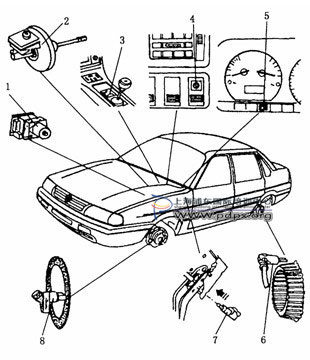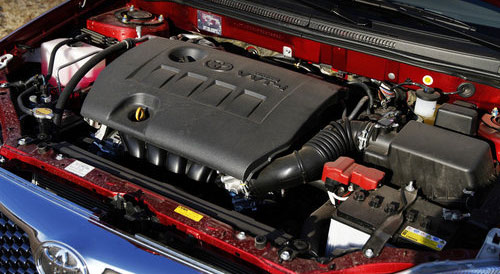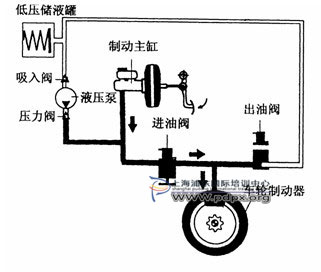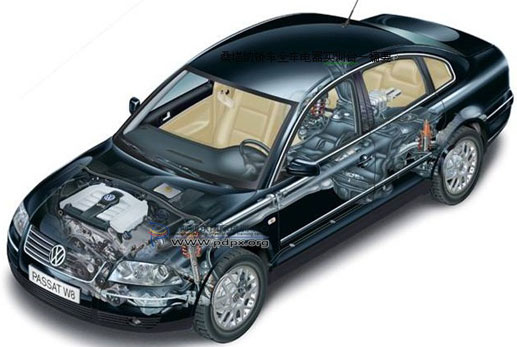First, the basic composition of the ABS system
This article refers to the address: http://
The ABS system can prevent the wheel from being locked, has the advantages of good steering stability during braking, steering ability while braking, and shortening the braking distance. The Santana 2000Gsi sedan adopts the American ITT MK20-I ABS system, which is a three-channel ABS regulation loop. The front wheels are individually adjusted, and the rear wheels are uniformly adjusted based on the side with low ground adhesion coefficient in the two wheels. The ABS system is mainly composed of ABS controller (including electronic control unit, hydraulic unit, hydraulic pump, etc.), four wheel speed sensors, ABS fault warning lights, brake warning lights, etc.

1-ABS Controller 2-Brake Master Cylinder and Vacuum Booster 3-Self-diagnostic Insert 4-ABS Warning Light (K47) 5-Brake Warning Light (K118) 6- Rear Wheel Speed ​​Sensor (G44/G46) 7 - Brake light switch (F)) 8-Front wheel speed sensor (G45/G47)
The basic working principle of the ABS system is: During the braking process of the car, the wheel speed sensor continuously transmits the speed signal of each wheel to the ABS electronic control unit (ECU) in time, and the ABS ECU inputs the four speed sensors according to the set control logic. The signals are processed to calculate the reference speed of the vehicle, the speed of each wheel, and the deceleration to determine the slip ratio of each wheel. If the slip rate of a certain wheel exceeds the set value, the ABS ECU issues a command to control the hydraulic control unit to reduce the brake pressure in the wheel wheel cylinder; if the slip rate of a certain wheel has not yet reached the set The ABS ECU controls the hydraulic unit to increase the brake pressure of the wheel. If the slip rate of a certain wheel is close to the set value, the ABS ECU controls the hydraulic control unit to maintain the brake pressure of the wheel. for sure. Therefore, the slip ratio of each wheel is kept within the ideal range, and the four wheels are completely locked.

During the braking process, if the wheel is not locked, the ABS system will not participate in the brake pressure control, and the braking process is the same as the conventional braking system. If the ABS fails, the electronic control unit will no longer control the hydraulic unit and light the ABS fault warning light on the instrument panel to send a warning signal to the driver. At this time, the ABS will not work and the braking process will be ABS's conventional brake system works the same.
Second, the work process of the ABS system
(1) Start braking phase (system oil pressure build-up)
When starting braking, the driver steps on the brake pedal, the brake pressure is generated by the brake master cylinder, and the frequently opened oil-free inlet valve acts on the wheel brake wheel cylinder. At this time, the oil is discharged without voltage. The valve is still closed, the ABS system is not involved in the control, the whole process is the same as the conventional hydraulic brake system, the brake pressure is constantly rising, as shown in the figure

(2) Oil pressure retention
When the driver continues to step on the brake pedal and the oil pressure continues to rise until the wheel is in a locked tendency, the ABS electronic control unit issues a command to energize the inlet valve and close the valve. The outlet valve remains closed without voltage, system oil Pressure remains unchanged
(3) Oil pressure reduction
If the brake pressure remains unchanged and the wheel has a locking tendency, the ABS ECU gives the oil valve energized to open the oil outlet valve, and the system oil pressure reduces the oil pressure through the low pressure liquid storage tank. At this time, the oil inlet valve continues to be energized and remains closed. The wheel with a locked tendency is released and the wheel speed begins to rise. At the same time, the electric hydraulic pump starts to start, and the brake fluid is sent from the low pressure liquid storage tank to the brake master cylinder.

(4) Increase in oil pressure
In order to optimize the braking, when the wheel speed increases to a certain value, the electronic control unit gives the oil valve power off, closes the valve, the oil inlet valve also opens without electricity, and the electric hydraulic pump continues to work from the low pressure liquid storage tank. The middle brake fluid is pumped into the hydraulic brake system, as shown in Figure 8-9. As the brake pressure increases, the wheel speed decreases again. This is repeatedly controlled cyclically (the operating frequency is 5-6 times/s, and the slip ratio of the wheel is always controlled at about 20%.
Mattress Staple,Durable Furniture Staple,Houseware Sofa Staple,Rust Proof Hog Rings Nails
Zhejiang Best Nail Industrial Co., Ltd. , https://www.beststaple.com
